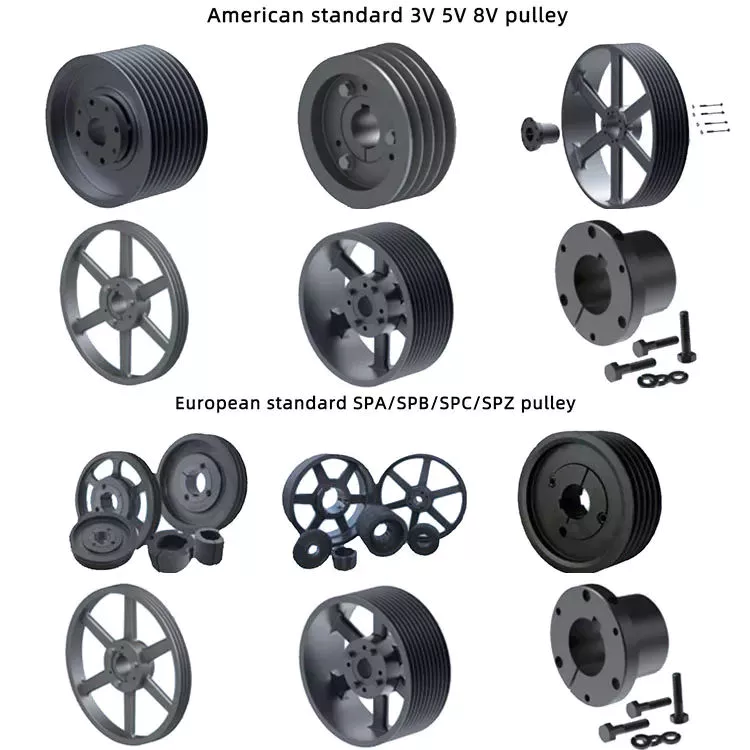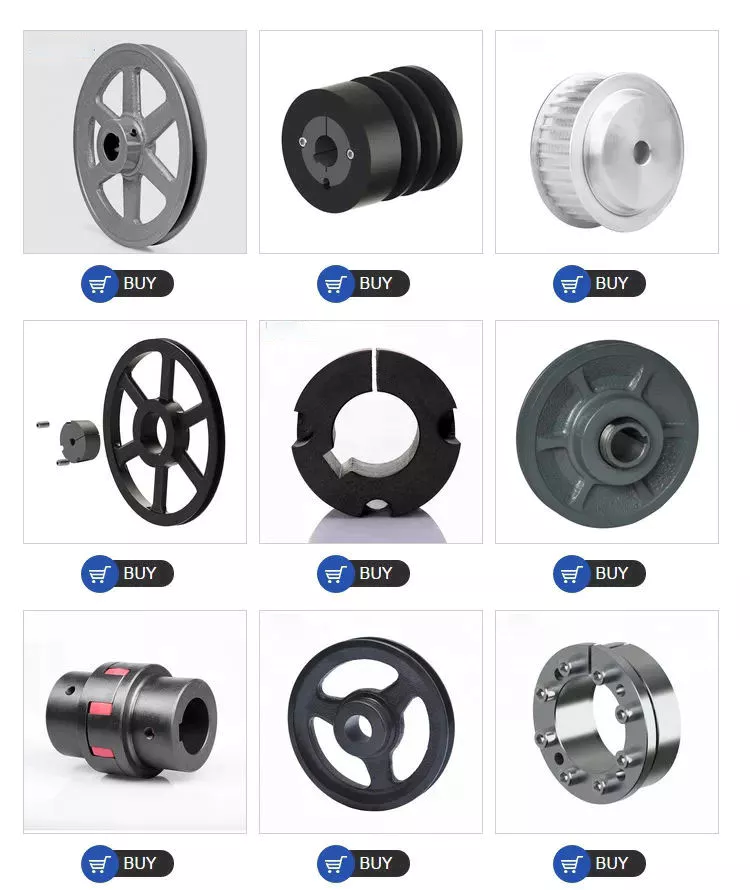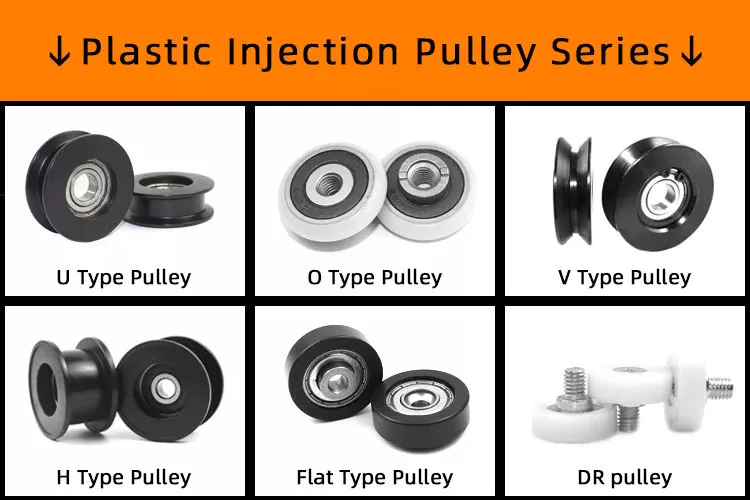Produktbeschreibung
Factory high quality Aluminum alloy 5mm bore 2 flanges GT2 GT3 GT5 GT8 GT14 timing belt pulleys
1) Warranty: our timing pulley's quality is very good and with ensurance within 1 year, when you receive the products and find quality problems, we promise you could return it back and free maintenance.
2) Drawings: please send you timing pulleys' drawings to us to get the best quotation; If you have no drawings, then we could work out CAD drawings and the best quotation to you ASAP.
3) Sample: we accept 1 piece sample's order, we could do samples until you're satisfied.
4) Confidentiality agreetment: Strictly adherence to client confidentiality agreetment for timing pulleys.
| Product Description |
|
Product Name |
Timing Belt Pulley | |
| Teeth profile | Trapezoidal toothed | MXL, XXL, XL, L, H, XH, XXH |
| T-toothed | T2.5, T5, T10, T20 | |
| Arc toothed | HTD3M, HTD5M, HTD8M, HTD14M, HTD20M, Gt2, Gt3, Gt5 | |
| S-toothed | S2M, S3M, S4.5M, S5M, S8M, S14M | |
| Parabolic-toothed | P2M, P3M, P5M, P8M, P14M | |
| Y-toothed | G2M, G3M, G5M, Y8M | |
| Teeth Quantity | 10-150 teeth or customized | |
| Inner Bore | 2-200mm H7 precision or customized | |
| Belt width | 4mm, 6mm, 9mm, 10mm, 12mm, 15mm, 20mm, 25mm, 30mm, 40mm, 50mm, 1/4”, 5/16”, 3/8”, 1/2”, 3/4”, 1”, 1.5”, 2”or customized | |
| Accessories | We can provide the service of assembling setscrews, bearings, shafts or taper bush | |
| Surface treatment | Anodize,Black Oxide,Phosphate and Galvanization | |
| Drawing Format | Timing belt pulley cad drawing,timing belt pulley UG drawing,Timing belt Pulley Soliwork drawing,Timing Pulley PDF drawing | |
What is timing pulley?
Timing pulleys are specialized pulleys that have either teeth or pockets around the outside diameter of the pulley body. Timing teeth engage holes in the metal belt, while timing pockets engage drive lugs on a belt's inner circumference. These teeth or pockets are used only for timing, not for power transmission.
How timing pulleys work?
The synchronous wheel transmission is composed of an endless belt with equal-spaced teeth on the inner peripheral surface and a pulley with corresponding teeth. During operation, the toothed teeth mesh with the tooth grooves of the pulley to transmit motion and power, which is integrated with the belt. A new type of belt drive with the advantages of transmission, chain drive and gear transmission.
What is gt2 timing pulley?
2mm pitch GT2 Pulley. The GT2 or 2GT Tooth Profile timing pulley prevails in the 3d printing hobby cause the Round tooth profile brings high precision of non-backlash, were known as today's Reprap Pulley.
What is a timing pulley flange?
Timing pulley flanges are used to maintain belt contact with a timing pulley in power transmission applications.Timing pulley flanges are manufactured to fit timing pulleys of the same pitch and size. The dimensions of a pitch, including the mating flange, are specified by the number of grooves.
What are synchronous belts used for?
The trapezoidal tooth profile first used on synchronous belts is recognized as standard. Belts with this configuration are commonly used in machine tools, textile machinery, home appliances, business equipment, and as camshaft drives in engines.
Note:Please confirm you need teeth profile, teeth quantity, belt width, bore diameter, quantity and type (please refer below drawings) to get our the most complete CAD drawings and the best quotation.
Related Products
| Certification: | ISO |
|---|---|
| Pulley Sizes: | Type F |
| Manufacturing Process: | Forging |
| Material: | Iron |
| Surface Treatment: | Baking Paint |
| Anwendung: | Chemical Industry, Grain Transport, Mining Transport, Power Plant |
| Proben: |
US$ 50/Piece
1 Stück (Mindestbestellmenge) | |
|---|
| Anpassung: |
Verfügbar
| Kundenspezifische Anfrage |
|---|

Can pulleys be used in both simple and complex mechanical systems?
Yes, pulleys can be used in both simple and complex mechanical systems. Pulleys are versatile mechanical devices that can be incorporated into a wide range of systems to transmit power, change direction, or provide mechanical advantage.
In simple mechanical systems, pulleys are often used to create a mechanical advantage by reducing the effort force required to lift or move a load. For example, a simple pulley system with a single fixed pulley can distribute the load's weight over multiple strands of rope or cable, reducing the force needed to lift the load. Simple pulley systems are commonly used in applications such as flagpoles, well buckets, or manual hoists.
In more complex mechanical systems, pulleys can be part of intricate arrangements to achieve specific functions. They can be combined with multiple pulleys, belts or ropes, and other mechanical components to create complex systems for power transmission, tensioning, or precise control. Examples of complex systems that utilize pulleys include conveyor belt systems, industrial machinery, cranes, and elevators.
Pulleys offer several advantages in both simple and complex mechanical systems:
1. Mechanical Advantage: Pulleys can provide a mechanical advantage by distributing the load's weight over multiple strands of rope or belt, reducing the effort force required to lift or move the load.
2. Direction Change: Pulleys can change the direction of the force applied, allowing for redirection of motion or routing of belts or ropes around obstacles.
3. Speed Adjustment: By adjusting the size of pulleys and the number of pulley systems, the speed of the output motion can be modified relative to the input motion.
4. Power Transmission: Pulleys are effective in transmitting power between shafts or components, allowing for the transfer of rotational motion and torque.
5. Versatility: Pulleys can be used with different types of belts or ropes, such as flat belts, V-belts, timing belts, or wire ropes, providing flexibility in design and application.
Whether in simple or complex mechanical systems, the selection, arrangement, and sizing of pulleys should be carefully considered to ensure proper functionality, efficiency, and safety. Manufacturers' guidelines, engineering principles, and best practices should be followed when incorporating pulleys into mechanical systems.

What is the importance of proper pulley alignment and tensioning?
Proper pulley alignment and tensioning are critical factors in ensuring the efficient and reliable operation of pulley systems. They play a significant role in maximizing power transmission, minimizing wear and tear, and maintaining the overall performance and longevity of the system. Here's the importance of proper pulley alignment and tensioning:
1. Power Transmission Efficiency:
Proper pulley alignment and tensioning ensure optimal power transmission efficiency. When pulleys are misaligned or belts/chains are improperly tensioned, energy is wasted due to increased friction and slippage. This results in decreased power transfer and reduced system efficiency. By aligning the pulleys parallel to each other and applying the correct tension to the belts or chains, the system can achieve maximum power transmission, minimizing energy losses.
2. Belt/Chain Longevity:
Correct pulley alignment and tensioning contribute to the longevity of belts and chains. Misalignment and inadequate tension can cause uneven wear, excessive stretching, and premature failure of the belts or chains. Proper alignment and tension distribute the load evenly across the belts or chains, reducing stress and extending their lifespan. This helps to avoid unplanned downtime, maintenance costs, and the need for frequent belt/chain replacements.
3. Reduced Noise and Vibration:
Improper pulley alignment and tensioning can lead to increased noise and vibration in the system. Misaligned pulleys or loose belts/chains can cause excessive vibration, resulting in noise, equipment damage, and discomfort to operators or nearby personnel. Proper alignment and tensioning help minimize vibration, ensuring quieter operation and a more comfortable working environment.
4. System Reliability and Safety:
Proper alignment and tensioning contribute to the overall reliability and safety of pulley systems. Misaligned pulleys or loose belts/chains can lead to unexpected failures, breakdowns, or accidents. Over-tensioning can also cause excessive stress on components and increase the risk of system failures. By maintaining proper alignment and tension, the system operates within its design parameters, reducing the likelihood of unexpected failures and ensuring the safety of operators and equipment.
5. Improved Performance:
Correct pulley alignment and tensioning enhance the overall performance of the system. Properly tensioned belts or chains provide better grip and traction, allowing for smoother and more precise movement of the driven components. This results in improved speed control, reduced slippage, and enhanced accuracy in applications such as conveyor systems, machine tools, and automotive engines.
6. Maintenance and Cost Savings:
Proper pulley alignment and tensioning can lead to significant maintenance and cost savings. Well-aligned pulleys and correctly tensioned belts or chains experience less wear and require fewer adjustments. This reduces the frequency of maintenance tasks, such as belt/chain replacements, realignments, and re-tensioning. Additionally, by maximizing power transmission efficiency and minimizing wear, proper alignment and tensioning help reduce energy consumption and lower operating costs.
In conclusion, proper pulley alignment and tensioning are crucial for achieving optimal power transmission efficiency, prolonging the lifespan of belts or chains, reducing noise and vibration, ensuring system reliability and safety, improving performance, and realizing maintenance and cost savings. It is essential to follow manufacturer guidelines and perform regular inspections and adjustments to maintain proper alignment and tension in pulley systems.

Welche Vorteile bietet die Verwendung von Riemenscheiben zur Steigerung der mechanischen Leistung?
Die Verwendung von Riemenscheiben zur mechanischen Verstärkung bietet in verschiedenen Anwendungen mehrere Vorteile. Hier sind die wichtigsten Vorteile:
1. Höhere Hubkapazität: Einer der Hauptvorteile der Verwendung von Seilrollen zur mechanischen Verstärkung besteht darin, dass sie das Heben schwererer Lasten mit weniger Kraftaufwand ermöglichen. Indem sie die Last auf mehrere Seil- oder Riemensegmente verteilen, reduzieren Seilrollen die zum Heben der Last erforderliche Kraft. Dies ist insbesondere in Szenarien von Vorteil, in denen manuelles Heben oder begrenzte Kraft erforderlich sind.
2. Einfachere Handhabung von Lasten: Flaschenzüge erleichtern die Handhabung und Kontrolle schwerer Lasten. Der mechanische Vorteil der Flaschenzüge verringert die zum Bewegen oder Anheben der Last erforderliche Kraft, sodass der Bediener weniger Kraft aufwenden muss. Dadurch werden Aufgaben wie das Anheben, Absenken und Positionieren schwerer Objekte einfacher und weniger körperlich anstrengend.
3. Sicherheit und Verletzungsprävention: Flaschenzüge verringern den Kraftaufwand beim Heben schwerer Lasten und tragen so zu mehr Sicherheit und Verletzungsprävention bei. Wenn der Bediener weniger körperliche Anstrengung aufwenden muss, verringert sich das Risiko von Zerrungen, Verstauchungen und anderen hebebedingten Verletzungen erheblich. Flaschenzüge ermöglichen eine kontrollierte und sanftere Lastbewegung und minimieren das Risiko plötzlicher Verschiebungen oder Stürze, die zu Unfällen führen könnten.
4. Präzise Lastpositionierung: Flaschenzugsysteme ermöglichen eine präzise Kontrolle der Lastpositionierung. Durch die Verwendung mehrerer Flaschenzüge und die Anpassung der Spannung im Seil oder Riemen können Bediener präzise vertikale und horizontale Bewegungen der Last erreichen. Dieses Maß an Kontrolle ist besonders wertvoll bei Anwendungen, bei denen schwere Objekte präzise platziert werden müssen, wie z. B. im Bauwesen, in der Fertigung und bei der Materialhandhabung.
5. Vielseitigkeit und Anpassungsfähigkeit: Riemenscheiben bieten Vielseitigkeit und Anpassungsfähigkeit in verschiedenen Anwendungen. Sie können in verschiedenen Anordnungen und Kombinationen konfiguriert werden, um je nach den Anforderungen der Aufgabe oder Last spezifische mechanische Vorteile zu erzielen. Riemenscheiben können problemlos in vorhandene Systeme integriert oder in kundenspezifische Konfigurationen eingebaut werden, wodurch sie sich sehr gut an unterschiedliche Situationen anpassen lassen.
6. Effiziente Kraftübertragung: Riemenscheiben sorgen für eine effiziente Kraftübertragung in mechanischen Systemen. Sie ermöglichen die Übertragung von Drehbewegungen und Kraft von einer Komponente auf eine andere mit minimalem Energieverlust. Der Einsatz von Riemenscheiben ermöglicht eine Optimierung der Kraftübertragung und gewährleistet eine effektive Nutzung der verfügbaren Kraftquellen.
7. Kosteneffizienz: Die Verwendung von Riemenscheiben zur mechanischen Verstärkung kann im Vergleich zu alternativen Methoden kostengünstig sein. Riemenscheiben sind relativ einfache und kostengünstige Geräte, die leicht erhältlich sind. Sie erfordern nur minimale Wartung und haben eine lange Lebensdauer. Darüber hinaus können Riemenscheibensysteme häufig ohne komplexe und teure Ausrüstung entworfen und implementiert werden.
Zusammenfassend lässt sich sagen, dass die Verwendung von Riemenscheiben zur mechanischen Verstärkung Vorteile wie erhöhte Hubkapazität, einfachere Lasthandhabung, Sicherheit und Verletzungsprävention, präzise Lastpositionierung, Vielseitigkeit, effiziente Kraftübertragung und Kosteneffizienz bietet. Diese Vorteile machen Riemenscheiben zu einem wertvollen Werkzeug in einer Vielzahl von Branchen und Anwendungen.


Herausgeber von CX
2023-12-15
